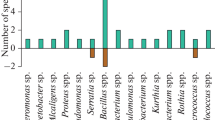Abstract
In chernozem soil, vanillin was decomposed via vanillic and protocatechuic acid before the aromatic ring opened. The rate curves of oxygen consumption for the oxidation of vanillin were seen to have more than one maximum. During incubation of the soil with vanillin, the number of bacteria increased, especially those capable of utilizing vanillin as the sole carbon source. Of the 21 such strains isolated, 15 were identified asPseudomonas sp., five asCellulomonas sp. and one asAchromobacter sp. It was found that the course of the oxidation of vanillin varied at different p.H values and in different strains was found that the course of the oxidation of vanillin varied at different p.H values and in different strains of bacteria. In some cases, the phase of the oxidation of vanillin to vanillic acid was clearly differentiated from the subsequent decomposition of vanillic acid.
Similar content being viewed by others
References
Bergey's Manual of Determinative Bacteriology. The Williams and Wilkins Co., Baltimore 1957.
Burges, A., Hurst, H. M., Walkden, S. B., Dean, F. M., Hirst, M.:Nature of humic acids. Nature 199: 696, 1963.
Cain, R. B.:The nature of the lactone in aromatic ring fission by bacteria. J. gen. Microbiol. 42: XIII, 1966.
Cain, R. B., Bilton, F. R., Darrah, J. A.:The metabolism of aromatic acids by microorganisms. Metabolic pathways in the fungi. Biochem.J. 108: 797, 1968.
Cartwright, N. J., Smith, A. R. W.:Bacterialattack on phenolic ethers. An enzyme system demethylating vanillic acid. Biochem. J. 102: 826, 1967.
Domsch, K. H.:Die Messung von Abbaufolgen im Boden. Soil organisms. Proceedings of the colloquium on soil fauna, soil microflora and their relationships Oosterbeek, The Netherlands, p. 22, 1962.
Drobník, J.:A Warburg vessel for soil samples. Nature 188: 686, 1960.
Flaig, W.:The chemistry of humic substances. In: The Use of Isotopes in Soil Organic Matter Studies. Pergamon Press p. 103, 1966.
Flaig, W.:Effects of micro-organisms in the transformation of lignin to humic substances. Geochim. Cosmochim. Acta 28: 1523, 1964.
Fukuzumi, T., Uranshihara, S., Oohashi, T., Shibamoto, T.:Enzymatic degradation of lignin. III. Oxidation accompanying carbon dioxide liberation of vanillic acid, vanilloylformic acid and guaiacyl pyruvic acid by enzyme of Polystictus sunguineus and Poria subacida. J. Japan Wood Res. Soc. 10: 242, 1964.
Gibson, D. T., Wood, J. M., Chapman, P. J., Dagley, S.:Bacterial degradation of aromatic compounds. Biotechnol. Bioeng. 9: 33, 1967.
Haider, K., Lim, S., Flaig, W.:Untersuchungen über die Einwirkung von Mikroorganismen auf 14C-markierte phenolische Verbindungen. Landwirtsch. Forsch. 15: 196, 1962.
Hais, I. M., Macek, K.:Paper chromatography. Publ. House Czechoslovak Acad. Sci. Prague, 1963.
Henderson, M. E. K.:Isolation, identification and growth of some soil Hyphomycetes and yeast like fungi which utilize aromatic compounds related to lignin. J. gen. Microbiol. 26: 149, 1961a.
Henderson, M. E. K.:The metabolism of aromatic compounds related to lignin by some Hyphomycetes and yeast-like fungi of soil. J. gen. Microbiol. 26: 155, 1961b.
Henderson, M. E. K.:Enrichment in soil of fungi which utilize aromatic compounds. Plant and Soil 23: 339, 1965.
Henderson, M. E. K., Farmer, V. C.:Utilization by soil fungi of p-hydroxybenzaldehyde, ferulic acid, syringaldehyde and vanillin. J. gen. Microbiol. 12: 37, 1955.
Hurst, H. M., Burges, N. A.:Lignin and humic acids. In: Soil Biochemistry. A. D. Mc-Laren and G. H. Peterson (editors) M. Dekker, Inc., New York, p.260, 1967.
Keil, B., Šormová, Z.:Laboratory technique of biochemistry. (In Czech) Publ., House Czechoslovak Acad. Sci. Prague 1959.
Kleinzeller, A., Málek, J., Vrba, R.:Manometric methods and their application for biology and biochemistry. (In Czech). SZN Praha, 1954.
Konetzka, W. A., Woodings, E. T., Stove, J.:Microbial dissimilation of methoxylated aromatic compounds. Bact. Proc. p. 135, 1957.
Kononova, M. M.:Soil organic matter. Its nature, its role in soil formation and in soil fertility. Pergamon Press, Oxford, London, New York, Paris, 1961.
Kune, F.:Effect of glucose on the decomposition of vanillin by soil microorganisms., Fol. microbiol. 16: 51, 1971.
Kune, F., Macura, J.:Oxidation of aromatic compounds in soil. Fol. microbiol. 11: 248, 1966.
Manual of Microbiological Methods. Society of American Bacteriologists. McGraw-Hill Book Co., New York, 1957.
Moreau, R., Augier, J.:Sur l'utilisation de la vanilline par les microorganismes du sol. C. R. Acad. Sci., Paris, 254: 555, 1962.
Moreau, R., Jacob, M., Augier, J.:Sur le métabolisme du phénol dans les sols. C. R. Acad. Sci. 251: 1179, 1960.
Neilands, J. B., Stumpf, P. K.:Outlines of enzyme chemistry. John Wiley & Sons, Inc., New York, 2nd edition, 1958.
Pawlaczyk-Szpilowa, M.:Microorganisms degradating phenol and some of their ecological features. (In Polish). Zeszyty naukowe Politechniki Wroclawskiej, Inźynieria Sanitarna VII 108: 3, 1965.
Rogoff, M. H.:Oxidation of aromatic compounds by bacteria. Advances Appl. Microbiol. 3: 193, 1961.
Schubert, W.J.:Lignin biochemistry. Academic Press, New York, London, 1965.
Smith, I.:Chromatographic Techniques. William Heinemann, London, 1958.
Sörensen, H.:Decomposition of lignin by soil bacteria and complex formation between autooxidized lignin and organic nitrogen compounds. J. gen. Microbiol. 27: 21, 1962.
Stanier, R. Y.:Simultaneous adaptation. A new technique for the study of metabolic pathways. J. Bacteriol. 54: 339, 1947.
Sundman, V.:The ability of α-conidendrin decomposing Agrobacterium strains to utilize other lignans and lignin-related compounds. J. gen. Microbiol. 36, 185, 1964.
Sundman, V., Kuusi, T., Kuhanen, S., Carlberg, G.:Microbial decomposition of lignins. IV. Decomposition of lignin by various micro-population. Acta Agricult. Scand. 14: 229, 1964.
Tabak, H. H., Chambers, C. W., Kabler, P. W.:Bacterial utilization of lignans. I. Metabolism of α-conidendrin. J. Bacteriol. 78: 469, 1959.
Taylor, C. B.:The nutritional requirements of the predominant flora of the soil. Proc. Soc. Appl. Bact. 14: 101, 1951.
Trojanowski, J., Leonowicz, A., Hampel, B.:Exoenzymes in fungi degradating lignin. II. Demetoxylation of lignin and vanillic acid. Acta microbiologica Polonica 15: 17, 1966.
Author information
Authors and Affiliations
Rights and permissions
About this article
Cite this article
Kunc, F. Decomposition of vanillin by soil microorganisms. Folia Microbiol 16, 41–50 (1971). https://doi.org/10.1007/BF02887334
Received:
Issue Date:
DOI: https://doi.org/10.1007/BF02887334




